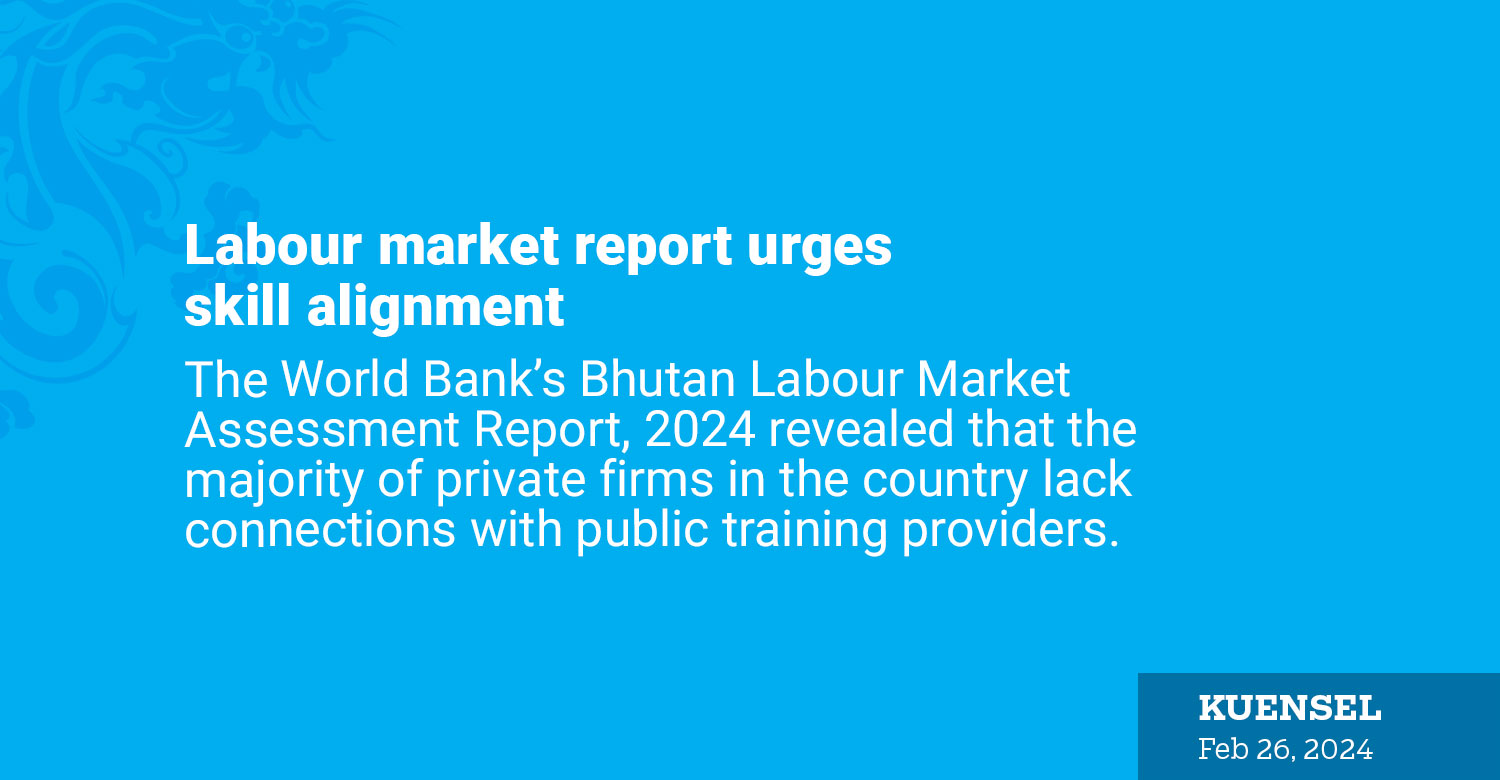KP Sharma
The World Bank’s Bhutan Labour Market Assessment Report, 2024 revealed that the majority of private firms in the country lack connections with public training providers.
This disconnection poses challenges, particularly in aligning training programmes with the actual labour demand in Bhutan.
According to the report, about 79 to 91 percent of firms do not have any connections with public or private colleges in the country, public technical or vocational institutions, private training institutes, government entities, private sector associations, or external training and education institutes.
The report recommends the necessity for a demand-driven approach and fostering closer collaboration between Technical and Vocational Education and Training (TVET) institutions and employers as such collaborative effort is essential to effectively tackle the identified skill mismatches in the labour market.
“The TVET programs offered have not been demand-driven because links with employers have been missing, leading to high unemployment among TVET graduates,” the report added.
In addition, the report highlights a lack of specific evidence indicating that the design and delivery of TVET training are conducted in partnership with employers.
Further, there has been an absence of discussions regarding cost-sharing arrangements with employers and the potential extent to which they could subsidise vocational training initiatives.
As a result, the report stated that the unemployment rate among TVET graduates remains relatively high and even those who manage to secure employment often find themselves working in sectors that are not aligned with future-oriented industries.
For instance, in 2022, only 67 percent of TVET graduates managed to secure employment within a year of graduating. Among the unemployed TVET graduates, nearly half, about 49 percent, expressed a need for further support in finding employment.
The report projects that the most in-demand sectors in the future will be services and sales, along with craft and related trades.
However, it revealed that as of 2022, the distribution of employment among individuals with TVET qualifications differed significantly.
It added that about 52 percent of employed individuals with TVET qualifications worked as technicians and associate professionals, while 20 percent worked as professionals.
Only nine percent were employed in the services and sales sectors, and seven percent were in craft-related occupations.
According to the report, there is an indication that TVET courses are providing individuals with skills that may not be in high demand in the future, raising concerns about the alignment of these courses with evolving market needs.
In addition, the report mentioned a geographical disparity, highlighting that public TVET institutions are not strategically located in proximity to employment opportunities, adding that this spatial mismatch could further contribute to challenges in connecting TVET graduates with relevant and available job opportunities.
In the academic years 2022–23, the only students enrolled at public TVET institutions graduated from the College of Zorig Chusum (CZC) and Jigme Wangchuck Power Training Institute (JWPTI). On the other hand, no graduates have emerged from TTI-Chumey since fiscal 2020-21.
“It is unclear from which regions TVET students come and whether they move after graduation.”
Moreover, there seems to be a shortage of employment opportunities in the areas where public TVET institutions are situated and certain regions may experience a higher demand for graduates than what TVET institutions can supply.
Further, the report stated the importance of the geographical proximity of TVET institutions to sectors and employers has not been thoroughly evaluated, indicating a potential oversight in assessing the effectiveness of the TVET system.
The report pointed to the lack of inclusivity within the TVET system, stating that private training providers and their graduates are predominantly concentrated in Thimphu, thus limiting opportunities for individuals in other regions.
While public TVET institutions are dispersed throughout the country, with an urban-centric focus, the majority of private training providers are concentrated in Thimphu, with fewer establishments in the eastern and central regions.
This concentration of private training providers in Thimphu appears to be primarily motivated by economic factors.
Thimphu boasts the highest concentration of individuals with suitable demographics for training and potential employment opportunities, making it an attractive location for such establishments.
However, such focus on the capital city indicates that private training providers are currently unable to adequately target vulnerable rural populations.
They are also unable to effectively contribute to the enhancement of rural economies. This geographic imbalance highlights a gap in the provision of training opportunities and economic development initiatives in rural areas.


